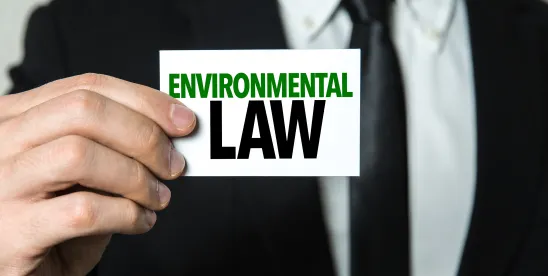The Chevron doctrine – the bedrock principle of administrative law under which courts afforded deference to administrative agency interpretations in the face of statutory ambiguity – is no more. On June 28, 2024, the U.S. Supreme Court issued a long-anticipated decision that addresses the authority of regulatory agencies to dictate policy and the extent to which courts will exercise their own judgment as to the meaning of a statute and how that may bound agency decisions. In two consolidated cases—Loper Bright Enterprises v. Raimondo, No. 22–451 (June 28, 2024), and Relentless, Inc. et al. v. Dep’t. of Com. et al., No. 22–1219, the Supreme Court has overruled a 40-year-old precedent first established in Chevron U. S. A. Inc. v. Natural Res. Defense Council, Inc., 467 U. S. 837 (1984), a 1984 Supreme Court case interpreting the Clean Air Act. While several cases over the past few years have “chipped away” at Chevron deference, increasing the role that the judicial branch plays in determining if agency actions went beyond statutory bounds set by Congress, Loper Bright squarely presented an opportunity for a Court increasingly focused on plain language to engage the role of courts in judging agency actions.
Today, we address the high points of the decision. The authors will follow up with additional posts addressing implications for the situations in which deference arises in environmental actions, such as rulemaking, enforcement, and regulatory interpretation (aka Auer or Skidmore deference).
The Chevron Doctrine Explained
The Chevron doctrine is derived from a 1984 Supreme Court decision, Chevron U.S.A., Inc. v. Natural Resources Defense Council, Inc., 467 U.S. 837 (1984), which held that courts must defer to an executive agency’s “reasonable interpretation” of ambiguous statutory language, even if the court itself might reach a different interpretation.
Specifically, Chevron established a two-step test for reviewing “an agency’s construction of the statute which it administers:”
- At Step 1, the court asks “whether Congress has directly spoken to the precise question at issue.” If yes, the court “must give effect to the unambiguously expressed intent of Congress.” But “if the statute is silent or ambiguous with respect to the specific issue,” the court moves to step 2.
- At Step 2, the court asks “whether the agency’s answer is based on a permissible construction of the statute.” If yes, the agency’s construction is “controlling.” At step 2, “a court may not substitute its own construction of a statutory provision for a reasonable interpretation made by the administrator of an agency.”
For decades, Chevron deference was thought to be a mechanism to promote stability and predictability in the law by deferring to experts in the agencies. Thousands of decisions—including 70 issued by the Supreme Court–have relied on the seminal case. Until now.
The Cases that Took Down Chevron
The two consolidated cases involve a challenge to certain Department of Commerce regulations promulgated in 2020 implementing the Magnuson-Stevens Act. The 2020 regulations require commercial fishing boats for the Atlantic herring fishery to pay the cost of carrying federal monitors on board. Commercial fishermen challenged the regulation and the U.S. Courts of Appeals for the First Circuit and the D.C. Circuit upheld the regulation, applying the Chevron doctrine and granting the agency deference. The Supreme Court granted certiorari in both cases to address the vitality and scope of the Chevron doctrine.
The Loper Bright Holding
In a 6-3 decision, with Chief Justice Roberts writing for the majority, the Court holds that “Chevron is overruled.” Slip Opinion at 35. The Chief Justice describes the flaws of the Chevron doctrine as follows:
Chevron defies the command of the [Administrative Procedure Act (APA)] that “the reviewing court”—not the agency whose action it reviews—is to “decide all relevant questions of law” and “interpret . . . statutory provisions.” §706 (emphasis added). [Chevron] requires a court to ignore, not follow, “the reading the court would have reached” had it exercised its independent judgment as required by the APA. Chevron, 467 U. S., at 843, n. 11. And although exercising independent judgment is consistent with the “respect” historically given to Executive Branch interpretations, see, e.g., Edwards’ Lessee, 12 Wheat., at 210; Skidmore, 323 U. S., at 140, Chevron insists on much more. It demands that courts mechanically afford binding deference to agency interpretations, including those that have been inconsistent over time. See 467 U. S., at 863. Still worse, it forces courts to do so even when a pre-existing judicial precedent holds that the statute means something else—unless the prior court happened to also say that the statute is “unambiguous.” … Chevron turns the statutory scheme for judicial review of agency action upside down.
Slip Op. at 21 (emphasis added).
Chief Justice Roberts continues:
Chevron cannot be reconciled with the APA by presuming that statutory ambiguities are implicit delegations to agencies. That presumption does not approximate reality. A statutory ambiguity does not necessarily reflect a congressional intent that an agency, as opposed to a court, resolve the resulting interpretive question. Many or perhaps most statutory ambiguities may be unintentional. And when courts confront statutory ambiguities in cases that do not involve agency interpretations or delegations of authority, they are not somehow relieved of their obligation to independently interpret the statutes.
Id. (emphasis added).
In response to the criticism from the dissenting justices that statutory ambiguities represent implicit delegations of authority to agencies, the opinion quotes a treatise by Cass Sunstein, a Harvard law professor and President Obama’s former Administrator of the Office of Management and Budget’s Office of Information and Regulatory Affairs (OIRA), which is the office that reviews all agency regulations before they are issued:
“[a]n ambiguity is simply not a delegation of law-interpreting power. Chevron confuses the two.” C. Sunstein, Interpreting Statutes in the Regulatory State, 103 Harv. L. Rev. 405, 445 (1989). As Chevron itself noted, ambiguities may result from an inability on the part of Congress to squarely answer the question at hand, or from a failure to even “consider the question” with the requisite precision. 467 U. S., at 865. In neither case does an ambiguity necessarily reflect a congressional intent that an agency, as opposed to a court, resolve the resulting interpretive question. And many or perhaps most statutory ambiguities may be unintentional.
Slip Op. at 22 (emphasis added).
The majority opinion goes on to reject each government argument in support of applying Chevron deference:
- Argument #1: Agencies are subject matter experts better equipped to address statutory ambiguities.
The Court refutes this argument, saying:
[E]ven when an ambiguity happens to implicate a technical matter, it does not follow that Congress has taken the power to authoritatively interpret the statute from the courts and given it to the agency. Congress expects courts to handle technical statutory questions … delegating ultimate interpretive authority to agencies is simply not necessary to ensure that the resolution of statutory ambiguities is well informed by subject matter expertise. The better presumption is therefore that Congress expects courts to do their ordinary job of interpreting statutes, with due respect for the views of the Executive Branch.
Slip Op. at 24–25 (emphasis added).
- Argument #2: Deferring to agencies’ interpretations promotes uniform construction and application of federal law, compared to judges exercising their “independent judgment,” which could result in disparate interpretations of the same law across the country.
The Court also rejects this argument writing:
Nor does a desire for the uniform construction of federal law justify Chevron. Given inconsistencies in how judges apply Chevron, [] it is unclear how much the doctrine as a whole (as opposed to its highly deferential second step) actually promotes such uniformity. In any event, there is little value in imposing a uniform interpretation of a statute if that interpretation is wrong.
Slip Op. at 25 (emphasis added).
- Argument #3: The interpretation of ambiguous statutory provisions amounts to policymaking best suited for the executive branch, not the Judicial branch.
The Court disposes of this argument with:
The view that interpretation of ambiguous statutory provisions amounts to policymaking suited for political actors rather than courts is especially mistaken, for it rests on a profound misconception of the judicial role …. Indeed, the Framers crafted the Constitution to ensure that federal judges could exercise judgment free from the influence of the political branches.
Slip Op. at 26 (emphasis added).
Justice Thomas writes “separately to underscore a more fundamental problem: Chevron deference also violates our Constitution’s separation of powers.” Thomas, J. concurring, at 2. He states:
Chevron deference compromises this separation of powers in two ways. It curbs the judicial power afforded to courts, and simultaneously expands agencies’ executive power beyond constitutional limits.
Slip Op., Thomas, J. concurring, at 2 (emphasis added).
Justice Gorsuch also writes separately and in his concurrence states:
Whenever we confront an ambiguity in the law, judges do not seek to resolve it impartially according to the best evidence of the law’s original meaning. Instead, we resort to a far cruder heuristic: “The reasonable bureaucrat always wins.” And because the reasonable bureaucrat may change his mind year-to-year and election-to-election, the people can never know with certainty what new “interpretations” might be used against them.
Gorsuch, J. concurring, at 19 (emphasis added). Interestingly, Justice Gorsuch makes a significant point of the dissent’s reliance on administrative law scholars finding “wiggle room” in the APA and then cites to articles written by former Justice Breyer and Justice Kagan that acknowledge conflicts between the APA and Chevron deference. Id. at 14.
Justice Kagan, joined by Justices Sotomayor and Jackson, writes a searing dissent for the Court’s small yet vocal minority, stating:
This Court has long understood Chevron deference to reflect what Congress would want, and so to be rooted in a presumption of legislative intent. Congress knows that it does not—in fact cannot—write perfectly complete regulatory statutes. It knows that those statutes will inevitably contain ambiguities that some other actor will have to resolve, and gaps that some other actor will have to fill. And it would usually prefer that actor to be the responsible agency, not a court. Some interpretive issues arising in the regulatory context involve scientific or technical subject matter. Agencies have expertise in those areas; courts do not.
Kagan, J. dissenting, at 2 (emphasis added).
Today, the Court flips the script: It is now “the courts (rather than the agency)” that will wield power when Congress has left an area of interpretive discretion. A rule of judicial humility gives way to a rule of judicial hubris. In recent years, this Court has too often taken for itself decision-making authority Congress assigned to agencies. The Court has substituted its own judgment on workplace health for that of the Occupational Safety and Health Administration; its own judgment on climate change for that of the Environmental Protection Agency; and its own judgment on student loans for that of the Department of Education. See, e.g., National Federation of Independent Business v. OSHA, 595 U. S. 109 (2022); West Virginia v. EPA, 597 U. S. 697 (2022); Biden v. Nebraska, 600 U. S. 477 (2023). But evidently that was, for this Court, all too piecemeal. In one fell swoop, the majority today gives itself exclusive power over every open issue—no matter how expertise-driven or policy-laden—involving the meaning of regulatory law. As if it did not have enough on its plate, the majority turns itself into the country’s administrative czar. It defends that move as one (suddenly) required by the (nearly 80-year-old) Administrative Procedure Act. But the Act makes no such demand. Today’s decision is not one Congress directed. It is entirely the majority’s choice.
Id. at 3 (emphasis added).
Justice Kagan, also quoting former OIRA Administrator Sunstein to support her interpretation that the APA does not preclude Chevron deference, writes:
In the years after the APA was enacted, the Court “never indicated that section 706 rejected the idea that courts might defer to agency interpretations of law.” Sunstein 1654. Indeed, not a single Justice so much as floated that view of the APA. To the contrary, the Court issued a number of decisions in those years deferring to an agency’s statutory interpretation.
Id. at 19.
She continues:
The majority’s whole argument for overturning Chevron relies on Section 706. But the text of Section 706 does not support that result. And neither does the contemporaneous practice, which that text was supposed to reflect. So today’s decision has no basis in the on practice, which that text was supposed to reflect. So today’s decision has no basis in the only law the majority deems relevant. It is grounded on air.
Id. at 23-24 (emphasis added).
In speaking to her view of the breadth of the majority decision, Justice Kagan writes:
Today, the majority … gives courts the power to make all manner of scientific and technical judgments. It gives courts the power to make all manner of policy calls, including about how to weigh competing goods and values … What actions can be taken to address climate change or other environmental challenges? What will the Nation’s health-care system look like in the coming decades? Or the financial or transportation systems? What rules are going to constrain the development of A.I.? In every sphere of current or future federal regulation, expect courts from now on to play a commanding role. It is not a role Congress has given to them, in the APA or any other statute. It is a role this Court has now claimed for itself, as well as for other judges.
The Substantive Result: A Potential Sea Change in How Environmental Law Has Operated for Decades
As Justice Kagan emphasizes, Loper Bright likely will facilitate a shift in administrative and environmental law which could result in courts deciding more important cases. While some commenters argue that the Supreme Court has not relied on Chevron in over a decade, Justice Kagan says the decision will cause a “massive shock to the legal system.” Id. at 24. In the immediate aftermath, however, many questions remain as to its practical import, for instance:
- What happens to previous rules that were upheld as being “reasonable” under Chevron Step 2 (when the statute was ambiguous)? The Court expressly states that it "does not call into question prior cases that relied on the Chevron” Slip Op. at 34. Justice Gorsuch, for his part, agrees. Nonetheless, Loper Bright’s holding may present opportunities for challenging settled rules when revised or when new parties are affected by them.
- Will Loper Bright really create more stability over time and stop the pendulum swings in policy at EPA? The Court writes that eliminating Chevron will bring more stability because administration changes should not result in changes in the law. To be sure, swings in environmental regulatory policy have occurred as administrations changed (e.g., Bush to Obama to Trump to Biden), but only time will tell if this decision will create more stability.
- How will courts implement Loper Bright’s directive to give “due respect” to agencies in future cases? While Chevron is overruled, the majority does indicate that agencies will receive due respect from courts. Op. at 25. Since courts will not have the technical expertise involved in many environmental issues, there will necessarily be some reliance on agency expertise. The open question is how this will play out under the new standard.
Implications of Loper Bright for the Next Supreme Court Term.
Next term, the Supreme Court will hear two important environmental law cases, giving an opportunity to see the Court apply Loper Bright. The first case, City & Cnty. of San Francisco v. Env’t Protection Agency, No. 23-753, presents the question of the EPA’s authority to impose narrative permit limitations under the Clean Water Act. The second case, Seven Cnty. Infrastructure Coalition v. Eagle Cnty., Col., No. 23-975, presents the question of the scope of an agency's review under the National Environmental Policy Act, and what agencies must consider when evaluating the indirect effects of an agency action, including potential downstream greenhouse gases resulting from development facilitated by the project.
The significance of Loper Bright remains to be seen. In the near term, agencies will likely factor this opinion into their decision-making knowing they will no longer receive Chevron deference. However, the long-term impacts of the Court’s opinion are still unknown.
Alexandra Hamilton, Kerry L. McGrath, Angela Morrison, Eric J. Murdock, Henry V. Nickel, Brent A. Rosser, Rachel Saltzman, Joseph C. Stanko, Gregory R. Wall, Abigail Contreras and Meredith Doswell contributed to this article









 />i
/>i

